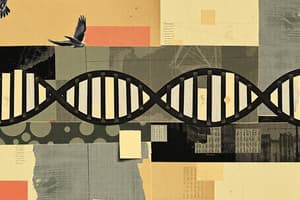Podcast
Questions and Answers
Which scientific claim is most consistent with the findings that transcription of gene R decreases when histone methyltransferase activity is inhibited?
Which scientific claim is most consistent with the findings that transcription of gene R decreases when histone methyltransferase activity is inhibited?
- Histone methylation condenses the chromatin at gene R so transcription factors cannot bind to DNA. (correct)
- Histone methylation has no effect on transcription of gene R.
- Histone methylation promotes accessibility of transcription factors.
- Histone methylation increases transcription of gene R.
Which of the following is most likely responsible for the seasonal change in coat color in arctic foxes?
Which of the following is most likely responsible for the seasonal change in coat color in arctic foxes?
- Exposure to sunlight enhances coat color.
- Lower temperature in winter denatures the pigment molecules. (correct)
- Higher temperatures increase pigment production.
- Diet changes affect fur color.
At what stage of protein synthesis can gene expression be controlled?
At what stage of protein synthesis can gene expression be controlled?
All of the stages except protein folding.
Structural genes are genes that code for the production of _____.
Structural genes are genes that code for the production of _____.
A sequence of CCT on a DNA molecule will ultimately match to the ____ sequence of an anticodon and the ____ triplet code for codon.
A sequence of CCT on a DNA molecule will ultimately match to the ____ sequence of an anticodon and the ____ triplet code for codon.
What is the function of a restriction enzyme?
What is the function of a restriction enzyme?
What is a cloning vector?
What is a cloning vector?
Where are restriction enzymes found?
Where are restriction enzymes found?
What are sticky ends?
What are sticky ends?
What is a dideoxynucleotide?
What is a dideoxynucleotide?
During replication, why are introns and exons kept and deleted?
During replication, why are introns and exons kept and deleted?
What is splicing?
What is splicing?
What are GMOs?
What are GMOs?
What is gene linkage?
What is gene linkage?
What is the function of structural genes?
What is the function of structural genes?
Why do complementary bases only pair with each other?
Why do complementary bases only pair with each other?
What is DNA replication?
What is DNA replication?
What are the steps of transcription?
What are the steps of transcription?
What occurs during transcription initiation?
What occurs during transcription initiation?
What occurs during transcription elongation?
What occurs during transcription elongation?
What happens during transcription termination?
What happens during transcription termination?
What is the final product of transcription?
What is the final product of transcription?
What is translation?
What is translation?
What occurs during translation initiation?
What occurs during translation initiation?
What happens during translation elongation?
What happens during translation elongation?
What triggers translation termination?
What triggers translation termination?
What is a polymerase?
What is a polymerase?
What is helicase?
What is helicase?
What are single-strand binding proteins?
What are single-strand binding proteins?
What is topoisomerase?
What is topoisomerase?
What is primase?
What is primase?
What are the models for replication?
What are the models for replication?
Steps of replication involve DNA ___ by breaking the hydrogen bonds between strands.
Steps of replication involve DNA ___ by breaking the hydrogen bonds between strands.
The leading strand is replicated continuously toward the replication fork in the ____ direction.
The leading strand is replicated continuously toward the replication fork in the ____ direction.
What is a primer?
What is a primer?
What is a lagging strand?
What is a lagging strand?
What are Okazaki fragments?
What are Okazaki fragments?
What are telomeres?
What are telomeres?
What is the lac operon for?
What is the lac operon for?
What is the trp operon?
What is the trp operon?
Flashcards are hidden until you start studying
Study Notes
Enzymes and Gene Regulation
- Histone methyltransferases methylate specific amino acid sequences in histone proteins, influencing gene expression.
- Inhibition of histone methyltransferase results in decreased transcription of gene R due to chromatin condensation.
- Restriction enzymes cut DNA at specific sites, protecting bacteria from foreign DNA by fragmenting it.
Coat Color Adaptation
- Arctic foxes change coat color with seasons; a white coat in winter and darker in summer.
- Seasonal coat color changes result from lower winter temperatures denaturing pigment molecules.
Gene Expression and Protein Synthesis
- Gene expression can be regulated at various stages except during protein folding.
- Structural genes are responsible for coding rRNA, tRNA, and mRNA; essential for protein synthesis.
- Different regions in DNA: introns (non-coding) and exons (coding for proteins). Introns are removed before mRNA exits the nucleus.
Transcription Process
- Transcription consists of binding, initiation, elongation, and termination, resulting in the production of pre-mRNA.
- RNA polymerase binds to the promoter, unwinding DNA for synthesis.
- Elongation involves RNA polymerase adding nucleotides in a 3' to 5' direction.
- Termination occurs when RNA polymerase reaches a specific sequence (TTATTT), detaching from the DNA.
Translation Overview
- Translation is the process where RNA is converted into a polypeptide chain.
- Initiation involves the small ribosomal subunit binding to mRNA and the assembly of the large ribosomal subunit.
- Elongation involves tRNA bringing amino acids based on codon sequences, forming peptide bonds as ribosome moves.
- Termination occurs when a stop codon is reached, triggering release factors to release the polypeptide.
DNA Replication and Repair
- DNA replication creates identical copies, involving the enzymes: helicase (unzipping DNA), topoisomerase (relieving strain), and primase (synthesizing RNA primers).
- Leading strand is synthesized continuously towards the replication fork while the lagging strand is synthesized discontinuously as Okazaki fragments.
- Telomeres protect DNA ends from degradation and help regulate cell division cycles.
Operon Functionality
- The lac operon functions for lactose digestion and is induced by lactose presence; a repressor blocks operon when lactose is absent.
- The trp operon synthesizes tryptophan; in its absence, the operon is active, while tryptophan presence inactivates it.
Cloning and Genetic Engineering
- Cloning vectors facilitate DNA insertion into plasmids.
- Sticky ends produced by restriction enzymes enable the joining of DNA fragments during cloning.
- GMOs are organisms with modified genes to alter specific traits.
Key Terms
- Dideoxynucleotides inhibit DNA polymerase and are used in DNA sequencing.
- Splicing is the removal of introns from pre-mRNA, joining exons to form mature mRNA.
Studying That Suits You
Use AI to generate personalized quizzes and flashcards to suit your learning preferences.




